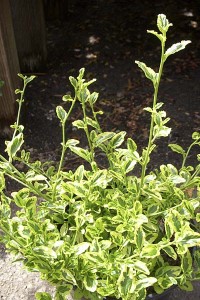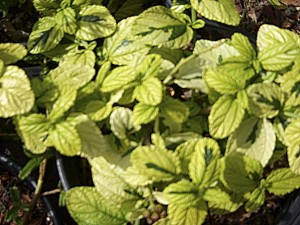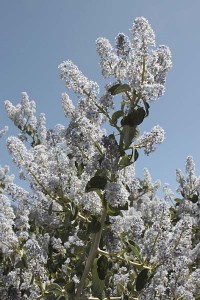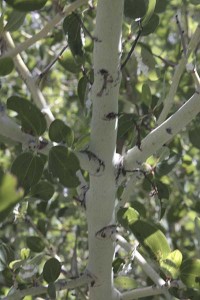On my last nursery trip I noticed a new horticultural ceanothus selection that I hadn’t encountered before. Ceanothus Tuxedo is striking because of its brown-black foliage, a leaf color I’ve never seen before on a ceanothus. In this photo you can see its large, dark foliage contrasted against the bright medium green of a more typical ceanothus.
Tuxedo arose as a mutation on a branch of Ceanothus Autumnal Blue, a hybrid of C. thyrsiflorus and C. ×delilianus (which is itself a hybrid of a hardy deciduous species with a more tender evergreen one). Autumnal Blue isn’t a plant that’s a typical constituent of California native gardens, instead being an old British hybrid that was bred for its hardiness. Also unlike its purely California brethren, it blooms in summer or fall, not in the spring.
The new Tuxedo selection is reputedly drought-tolerant. Looking at its ancestry, however, it’s clear it will require some supplemental summer water in dry climates. There’s no question that it appreciates good drainage. Mature height is listed as at least six feet high and across.
Next to Tuxedo in the nursery were a couple variegated ceanothus. C. thyrsiflorus ‘El Dorado’ features small light green/dark green leaves on a large shrub. In summer the leaves will show more contrast, with the light green turning more of a yellow color.
If you want yellow-and-green leaves in a more spreading ceanothus, there’s C. griseus horizontalis ‘Diamond Heights.’ (Sorry for the fuzzy photo…) You could think of it as a variegated version of a well known groundcover ceanothus like ‘Yankee Point.’
Both of the above could be considered low-water (not no-water) plants for a garden.
California native plant purists might think twice before planting any of these selections. They scream that they’re garden plants and not visitors from the wilds. But these ceanothus do give you more options if you’d still like your plants to have a bit of laid back California attitude to them.
The last ceanothus I want to share is a wild plant, taken about ten days ago just outside the Santa Ysabel Open Space Preserve in the San Diego County foothills. Chaparral whitethorn (C. leucodermis) has got to be one of the most unique of the genus, combining fluffy, vaporous blue-tinged white flowers with a plant that has bark as white as an aspen. It’s an amazing effect.
But unfortunately the plant appears to be singularly difficult to grow in anything but the perfect garden spot. Taking up the slack is a garden-friendly hybrid, L.T. Blue (L.T. equals leucodermis x thyrsiflorus), which preserves the white bark color and blue (if not misty blue) flowers of leucodermis in combination with the much more garden-tolerant C. thyrsiflorus. Las Pilitas carries it, and this last photo is from their site.







Very jealous. Ceanothus typically hate lots of water and humidity. So, as you can imagine, dislikes the south intensely. I will admire from a far.
Although, I have mastered growing agastache without drowning them. Maybe one day…
The great thing about Diamond Heights is that it can tolerate part shade (mine gets maybe 4 hours of morning sun, then a bit here and there during the day through the redwoods. And with that brilliant colour, it really lights up the shade. I have it in a pot, and it’s worked out quite well.
Jenny, I think the agastache is an accomplishment where you are, even if ceanothus might elude you. Uh oh. Sounds like a challenge you can’t refuse.
Town Mouse, it sounds like you’ve got a perfect spot for it–something that’s both to its liking and where it looks great. I’ll have to admit to being tempted by the Tuxedo, and won’t be surprised if it ends up in the yard in the next couple of weeks–I’ve got a spot for a plant with dark foliage.
I’m always pleased and amazed by our many and seemingly constantly-hybridizing local ceanothus, but I’m no purist: ‘Tuxedo’ and the others look great to me, and I like the idea of a summer-flowering ceanothus. Very informative post, thanks.
Pomona, thank you. Like you I’m always amazed by what two plants can produce when they hybridize, and then add some cool mutations on top of the rich gene pool–as with Tuxedo.
The protests against garden plants by native plant people always interest me, in that it takes a very grey area and colors everything black and white. It’s a garden plant because it was selected by a nursery? So were most of the so-called species plants available for purchase. Unless you do a restoration project, collecting seed from the immediate wildlands and raising it to plant out, you’re planting garden plants. And do native plant purists really want the general public harvesting remaining native populations?
I am glad to see my Ceanothus Tuxedo shared with all you folk in California. I really hope it does well there and I know its not pure pure native but it is all American native in East meets west style. For what its worth it seems to thrive much better in your glorius California sun than it does under our grey clouded land here. It grows very well here but the colour depth it reaches in California tells me its happiest there.
I hope it adds to your garden tapestry.
Thank you for highlighting this plant.
Pat FitzGerald.